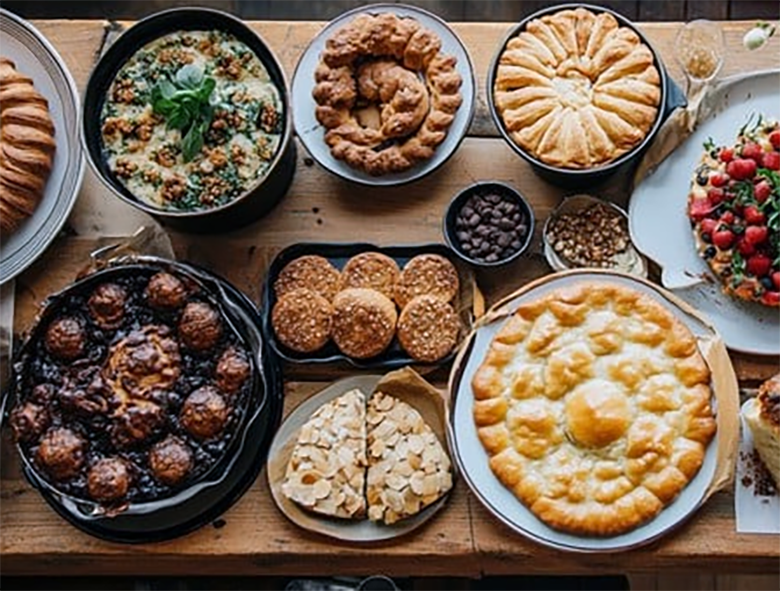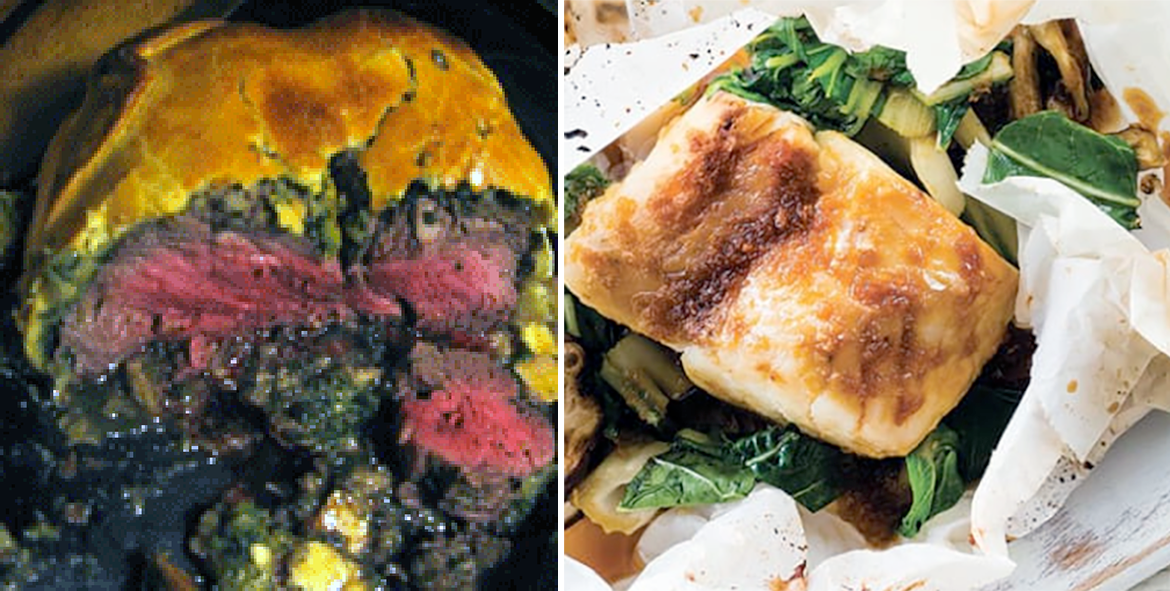FabulousFusionFood's Baking Recipes 8th Page
 A range of baked goods.
A range of baked goods.
Welcome to FabulousFusionFood's Baking Recipes Page — This is a continuation of an entire series of pages that will, I hope, allow my visitors to better navigate this site. As well as displaying recipes by name, country and region of origin I am now planning a whole series of pages where recipes can be located by meal type and main ingredient. This page gives a listing of all the baking recipes added to this site. Baking is defined as a technique for the prolonged cooking of food using dry heat by the action of conduction. Baking is normally done in an oven, but goods may also be baked in hot ashes or on hot stones. Baking differs from Roasting Recipes in that a lower temperature is typically used and the items are cooked for a longer period of time. Baking is a much older process than most people think and foods were probably originally baked in embers or with hot stones (which is how bread may have started). Only later did specialist ovens develop. Though most baked goods tend to be bread or cake-based some other dishes such as pasta dishes and vegetable dishes may also be baked. Stews are often also technically baked in an oven, but are not classed as 'baked goods' in that they are more liquid than solid at the end of the cooking process.
Baking is a method of preparing food that uses dry heat, typically in an oven, but can also be done in hot ashes, or on hot stones. The most common baked item is bread, but many other types of foods can be baked. Heat is gradually transferred "from the surface of cakes, biscuits and cookies, and pieces of bread to their centre, typically conducted at elevated temperatures surpassing 150°C. Dry heat cooking imparts a distinctive richness to foods through the processes of caramelization and surface browning. As heat travels through, it transforms batters and doughs into baked goods and more with a firm dry crust and a softer centre. Baking can be combined with grilling to produce a hybrid barbecue variant by using both methods simultaneously, or one after the other. Baking is related to barbecuing because the concept of the masonry oven is similar to that of a smoke pit.
In addition to bread, baking is used to prepare cakes, pastries, pies, tarts, quiches, biscuits and cookies, scones, crackers, pretzels, and more. These popular items are known collectively as 'baked goods', and are often sold at a bakery, which is a store that carries only baked goods, or at markets, grocery stores, farmers markets or through other venues.
 Beef en croûte (left) and fish en papillote (right).
Beef en croûte (left) and fish en papillote (right).
The alphabetical list of all the baking recipes on this site follows, (limited to 100 recipes per page). There are 2205 recipes in total:
Page 8 of 23
| Decorated Simnel Cake Origin: Britain | Dulse Muffins Origin: Britain | Ecclefechan Butter Tart Origin: Scotland |
| Deep Pan Pizza Dough Origin: American | Dulse Quiche Origin: Britain | Eggnog Christmas Bread Origin: British |
| Devil's Food Cake Origin: American | Dulse Soda Bread Origin: Ireland | Egyptian Basboosa (Semolina Cake) Origin: Egypt |
| Devil's Food Cake II Origin: American | Dulse Soda Scones Origin: Ireland | Elderberry and Chocolate Muffins Origin: Britain |
| Devil's Food Cake Mix Cake Origin: American | Duncan Hines Deluxe Dark Chocolate Cake Mix Cake Origin: American | Elderflower Cupcakes Origin: Britain |
| Devonshire Honey Cake Origin: England | Dundee Biscuits Origin: Scotland | Elderflower Tart Origin: British |
| Dewberry Muffins Origin: Britain | Dundee Cake Origin: Scotland | Elizabethan Cheese-curd Tart Origin: England |
| Diabetic Cheesecake Origin: American | Dundee Mince Pie Origin: Scotland | Elus Bakyn in Dyshes (Eels baked in dishes) Origin: England |
| Digestive Biscuits Origin: England | Dunesslin Pudding Origin: Scotland | Empadãi de Queijo (Cheese Pie) Origin: Brazil |
| Dinca 'Fala (Apple Cake) Origin: Welsh | Dunfillan Pudding Origin: Scotland | Empanada Gallega (Spicy Galician Chicken Empanada) Origin: Spain |
| Dobos Torte (Drum Cake) Origin: Hungary | Easter Biscuits Origin: England | Empanadas Origin: Chile |
| Dobos Torte II (Drum Cake II) Origin: Hungary | Easter Biscuits II Origin: Britain | Empire Biscuits Origin: Britain |
| Dominican Pan de Agua (Dominican Breakfast Water Bread Rolls) Origin: Dominican Republic | Easter Biscuits III Origin: British | Enchiladas (Stuffed Tortillas with Chilli Sauce) Origin: Spain |
| Dornoch Dreams Origin: Scotland | Easter Brunch Sausage Strata Origin: Britain | Enchiladas de Espinaca (Spinach Enchiladas) Origin: Mexico |
| Dorset Sausage Pasties Origin: Britain | Easter Bunny Biscuits Origin: Britain | Endive and Asparagus Gratin Origin: Belgium |
| Double Blackcurrant Cheesecake Origin: Britain | Easter Cake Origin: American | English Cottage Pie Origin: England |
| Double Blueberry Cheesecake Origin: Britain | Easter Carrot Cake Origin: Britain | English Madeleines Origin: England |
| Double Chocolate Cake Mix Cake Origin: American | Easter Carrot Cake Cupcakes Origin: British | English Madeleines Origin: Britain |
| Double Chocolate Cheesecake Muffins (Double Chocolate Cheesecake Muffins) Origin: New Zealand | Easter Crown Bread Origin: Europe | Enkhytoi (Roman Honey Cakes) Origin: Roman |
| Doughboy Origin: Saint Vincent | Easter Cupcakes Origin: American | Eog Cothi Pob (Baked Cothi Salmon) Origin: Welsh |
| Dover Sole á la Meuniere Origin: France | Easter Egg Biscuits Origin: Britain | Eog Gyda Saws Corgimychiaid (Salmon with Prawn Sauce) Origin: Welsh |
| Dresdner Stollen Origin: Germany | Easter Flower Cupcakes Origin: Britain | Eog Wedi Crasu Gyda Bara Lawr â Chaws (Baked Salmon with Laver Bread and Cheese) Origin: Welsh |
| Dress-up Dress-down Meatloaf Origin: Australia | Easter Fruit Cake Origin: Britain | Eog wedi ei Bobi gyda Thatws a Teim (Salmon Baked with Potatoes and Thyme) Origin: Welsh |
| Dried Fish Origin: Liberia | Easter Lamb Bobotie Origin: South Africa | Erbolat Origin: England |
| Dried Rose Hip Custard Crumble Pie Origin: American | Easter Lamb Cake Origin: Britain | Eve's Pudding Origin: England |
| Dried Tamarillos Origin: British | Easter Ledge Pudding Origin: Ancient | Eve's Pudding II Origin: Britain |
| Drisheen Origin: Ireland | Easter Lemony Chocolate Cake Origin: Britain | Excellent Small Cakes Origin: Britain |
| Dry Baking Mix Origin: American | Easter Rice Pudding Origin: American | Fairy Cakes Origin: Britain |
| Dry Baking Mix Biscuits Origin: American | Easter Rolls Origin: Britain | Fanouropita (Greek Spiced Sultana Cake) Origin: Greece |
| Dry Baking Mix Muffins (Dry Baking Mix Muffins) Origin: American | Easter Sunday Saffron Cake Origin: Cornwall | Far Breton à la Cerise (Breton Far with Cherries) Origin: France |
| Duck Egg Victoria Sponge Origin: Britain | Easter Tansy Origin: Britain | Far breton aux pruneaux (Breton Far with Prunes) Origin: France |
| Dulce de Tres Leches (Cream of Three Milks) Origin: Peru | Easter Teabread Origin: Britain | Farina Pie Origin: Bermuda |
| Dulcia Piperata (Peppered Sweets) Origin: Roman | Easter White Chocolate and Lime Cheesecake Origin: Britain | |
| Dulse and Chocolate Bouchons Origin: France | Easy Praline Cookies with Tonka Beans Origin: British |
Page 8 of 23